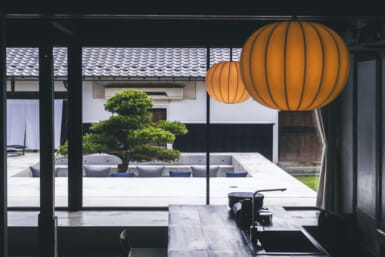by Ian Priestley
There is nothing quite like sado (tea ceremony) to split the foreign community. On one hand, you have those who consider it a close second to Noh in being one of those impenetrable Japanese art forms whose very mention elicits a Pavlovian yawn. Then there are the standard bearers of traditional Japanese arts for whom it represents the quintessence of Japanese aesthetics and culture, a ritual through which one can learn the principles of harmony, respect and tranquility, so missing in our world today.
This divide seems to extend to Japanese society, becoming a symbol of a generation war. Shunned by the young, alongside ikebana and kyudu, in favor of hip-hop, easy sex and moral dissipation, tea ceremony has become a rallying cry for an older generation which fears the values of traditional Japanese culture will be laid to rest in an unmarked grave by gun-toting militia children from “Battle Royale,” weaned on KFC and Starbucks.
Avoiding trouble on the mean streets of Tokyo, I made my way to the Tokyo Metropolitan Teien Art Museum to witness first hand a tea ceremony with a difference.
Just as the museum itself represents a more harmonious mixing of cultures (an art deco building constructed in the Meiji Era when the west meant more than a Big Mac and David Beckham), the tea ceremony I was about to witness was of the new school, Sencha Doh, and sought to restate the positive aspects of east-west fusion by blending traditional Japanese tea ceremony with a European sweetener.
Kimono was to be forsaken for western-style clothes, and the tea was to be Darjeeling. There would also be English crockery and a side plate of sandwiches, as well as the traditional cake. Hardly a 1.5 on the revolutionary Richter scale you might think, but to some traditionalists in the tea world, the equivalent of Bob Dylan going electric.
Dress, I was told, would be formal, and I was instructed not to wear a watch, as we were to forget the pressures of time and other worldly burdens.
We were shepherded into the tearoom where each table had five chairs, a traditional flower arrangement and a charcoal stove. The Wedgwood cups and saucers added a dash more color to the display than is usual. I sat down with a group of middle-aged ladies resplendent in Dior and Hermes, and realized, looking around the room, the art of sado was very much a female preserve – I was the only man present. I felt I was being eyed slightly suspiciously until I was asked from which country I came. The response “Britain” induced a round of knowing nods and “wakarimashitas.” The refined, English tea connoisseur.
I began to relax slightly as I slid into stereotype, as one tends to in Japan, to simplify things: the smiling but slightly retarded English teacher; the foreign dinner guest who is jozu with chopsticks and likes all kinds of Japanese food (except, of course, the notorious natto). And, if things went badly at the ceremony and I managed to knock over the pot and inflict a severe burn on Coco Chanel to my right, then there was always the last resort of an Englishman in Japan— the Hugh Grant sympathy stammer.
Calmed by the realization I wasn’t a caffeine-craving espresso junkie about to destroy the destroy karma, but a tiffin-drinking Brit, the pot was placed on the charcoal stove and the tea ceremony commenced.
I once had a Japanese friend in London who, confronted with a chest of drawers in her bedroom in which each drawer somehow managed not quite to fit, as if designed to sabotage any useful purpose the piece of furniture might be put to, had declared: “The difference between English and Japanese is that English people don’t care about the detail.”
Watching my tea hostess, rotating each cup through four 45-degree turns as she wiped them, I realized how such a lack of attention might affect the Japanese sense of aesthetics. The attention to detail was everything.
It was Rikyu, the 16th century tea master, who perfected the way of tea, which embodied the Zen belief that every act of daily life can lead to enlightenment, emphasizing beauty in the simple objects and acts of daily life.
Every movement my hostess made was part of an elaborate kata, from the tilt of the teapot to the placing of the cups—identically offered like a meishi—with a cake by the side of each, all done with painstaking symmetry.
And then we were invited into the ritual. I would have been happy to let the tea maker continue and to watch in awe from afar—the involvement of the five other ladies and me seemed to destroy the calm and even add a bit of tension to the proceedings. Gradually though, in silence, cups were lifted, crockery gently tinkled, and my stomach rebelliously rumbled like a freight train.
One of the Dior ladies delicately broke off a piece of the cake and, domino-like, so did the next, as if they belonged to some cake-eating chorus line. I began to wonder if there was some rehearsal for the whole business I had missed.
Ignoring the urgent messages of hunger my stomach was frantically paging to my head, I attempted a dignified nibble of cake.
A semi-circle of empty cups with a small uneaten piece of cake of almost exactly the same size by the side of each cup singled the end of the first round; the symmetry only spoiled by my own offering where the remnants of my own cake lay crumbled like a ruined city.
Round two began and once more I watched in awe as the tea server returned to the carefully proscribed rhythm of her movements.
But this time there were conflicts; my mind began to think un-Zen-like thoughts: I wanted to know how much longer this was going to take; whether there was a restaurant nearby, or if it was possible to have a cigarette break in tea ceremony.
The extent of my mind’s wanderings struck me when the next cup of tea was offered, I had just completed the lineup of an all-bearded England soccer team in my mind.
As I left the grounds of the gallery en route to a far less sedate dining experience, I felt glad I had attended the tea ceremony. I was fascinated and awestruck by such dedication to detail, ritual and manner that formed the basis of this and many other aspects of Japanese lifestyle, from learning endless kanji at school to an ordinary meishi exchange, which surely had helped endow Japan with a discipline and harmony that was the envy of the world.
Part of me, however, wanted to tear off my tie, run for the hills and listen to hip-hop, with that typical western fear that the flip side of the harmony coin meant a soul-crushing suppression of the individual will.
Next day in school I shared the previous day’s experience with one of my high school students. He gave me a pitying look, before describing in detail the goriest scenes in “Kill Bill.”.








